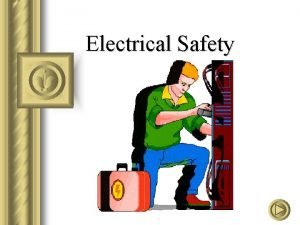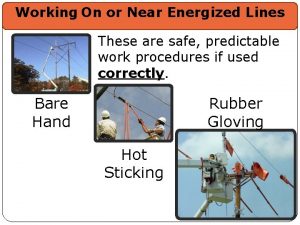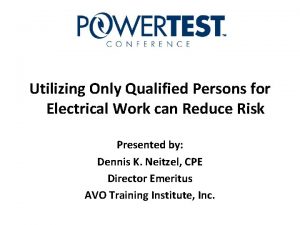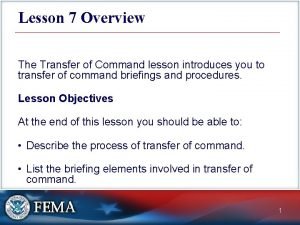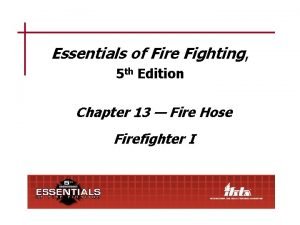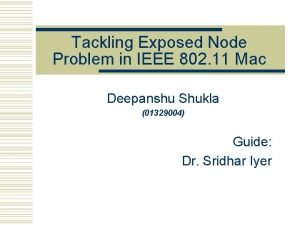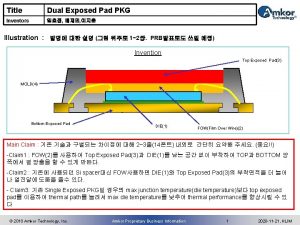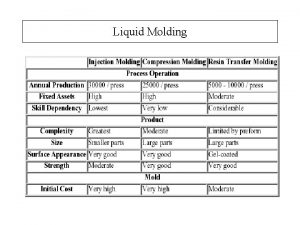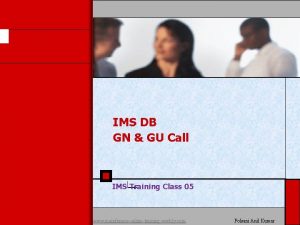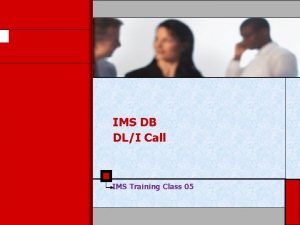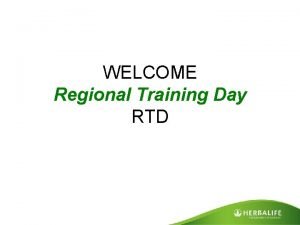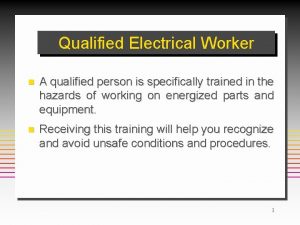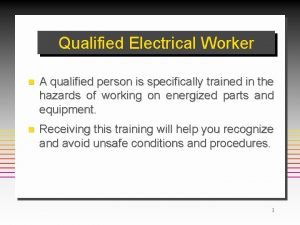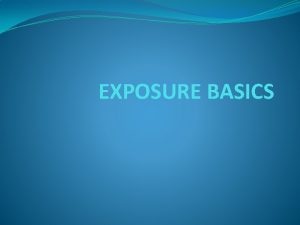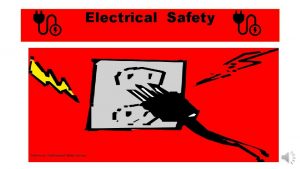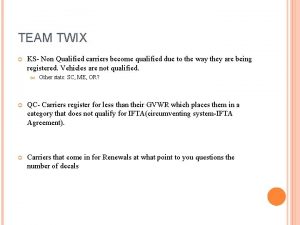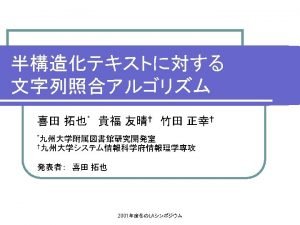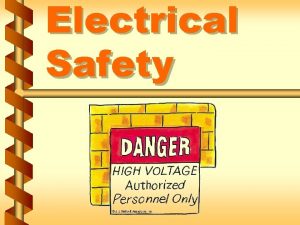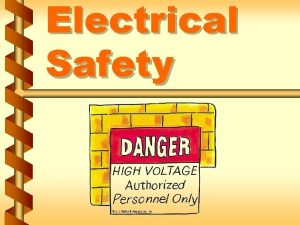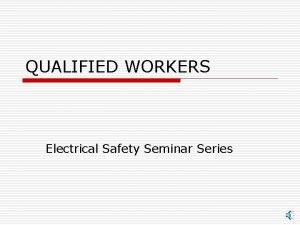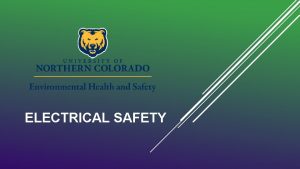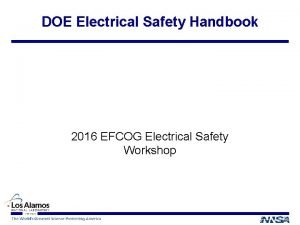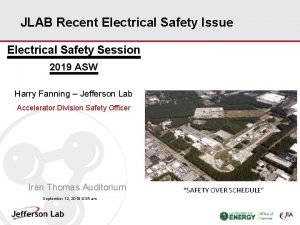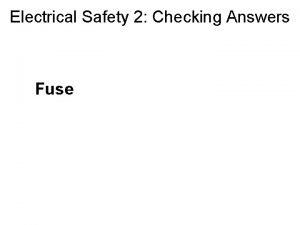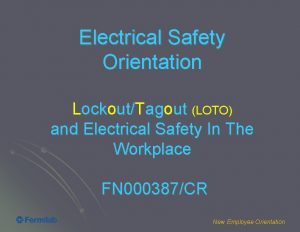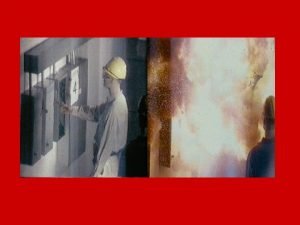Electrical Safety Qualified Person Energized exposed electrical parts














































- Slides: 46

Electrical Safety. Qualified Person

Energized exposed electrical parts v Exposed parts v Live or energized parts v De-energized parts 1 a

Energized exposed electrical parts v Exposed parts that are deenergized, but not locked/tagged are considered energized, exposed parts 1 b

Working near exposed parts v Only qualified workers can work on or near exposed electrical parts 2 a

Working near exposed parts v Live parts operating at less than 50 volts to ground do not need to be de-energized when: • the worker experiences no increased exposure to electrical burns or explosions due to electrical arcs 2 b

Working near exposed parts v Lockout/tagout must be performed by a qualified person v Who is considered a qualified person? 2 c

Working near exposed parts v Types work: of excluded electrical • general, transmission, distribution installations • communications installations • vehicle installations • railway installations 2 d

Distinguishing exposed live parts from other parts v Qualified persons use voltage testing equipment to identify live and de-energized parts v Testing equipment must be rated for the anticipated voltages to be tested 3 a

Nominal voltage of exposed live parts v Nominal voltages are values assigned to circuits to designate its voltage class • 120/240 • 480 Y/277 • 600 4 a

Nominal voltage of exposed live parts v The actual voltage at which a circuit operates can vary from the nominal within a range that permits satisfactory operation v Multi-meters/volt-ohm identify voltage meters 4 b

Clearance distances - Unguarded/energized overhead lines v The required distance between the workers and a conductive object that they could contact 5 a

Clearance distances - Unguarded/energized overhead lines v Used when working below unguarded, energized lines 5 b

Clearance distances - Unguarded/energized overhead lines Exceptions to required distances: v The worker is wearing insulated equipment 5 c

Clearance distances - Unguarded/energized overhead lines Exceptions to required distances: v The energized part is insulated from the worker, and all conductive parts at a different potential 5 d

Clearance distances - Unguarded/energized overhead lines Exceptions to required distances: v The worker is insulated from all conductive objects at a different potential than the energized part 5 e

Clearance distances - overhead lines and vehicles/equipment v Voltages 50 kv or less, the clearance distance is 10 feet v Voltages greater than 50 kv, the clearance is 10 feet plus 4 inches for every 10 kv over 50 kv 6 a

Clearance distances - overhead lines and vehicles/equipment v When the vehicle is in transit, and the structure is lowered: • the clearance distance is 4 feet for 50 kv or less; or • 4 feet plus 4 inches for every 10 kv over 50 kv for voltage greater than 50 kv 6 b

Clearance distances - overhead lines and vehicles/equipment v Insulating barriers • When installed but not attached to a vehicle, the clearance distance is the designed working dimensions of the barrier v Refer to Table S-5 for aerial lift clearance distances 6 c

Clearance distances - overhead lines and vehicles/equipment v Employees must not come into contact with vehicles/equipment under an energized line unless the: • employee is wearing proper PPE • equipment/vehicle is located so that no uninsulated part can provide a conductive path to employees 6 d

Clearance distances - overhead lines and vehicles/equipment v Do not stand near grounding locations for intentionally grounded equipment/vehicles when contact with overhead wires is possible • Insulation and barriers 6 e

Illumination v Do not enter an area containing exposed energized parts unless the area is illuminated v Do not work near exposed energized parts unless the area is properly illuminated v Do not reach into blind areas 7 a

Confined spaces v Barriers, shields, and insulation provide protection from energized parts v Secure doors, hinged panels to prevent exposure to energized parts 8 a

Handling conductive materials/equipment v Carefully handle conductive materials or equipment that come in contact with your body v Prevent contact with exposed energized parts 9 a

Handling conductive materials/equipment v Carefully handle long, conductive objects in areas containing exposed energized parts • Insulation • Guarding • Materials handling 9 b

Nonconductive ladders v Portable ladders must have nonconductive siderails if they could contact exposed energized parts v Metal ladders can conduct electricity and cause arcing and shocks 10 a

Hazards of conductive apparel v Conductive jewelry and clothing can cause arcing when exposed to energized parts v Remove or cover conductive jewelry and clothing to eliminate risk of conductivity 11 a

Procedures for using portable electrical equipment 12 a

Proper handling of cords v Don’t raise or lower equipment by its cord v Don’t unplug the equipment by pulling on its cord v Don’t staple or fasten the cord so as to damage outer jacket 12 b

Equipment inspection v Visually check for: • loose parts • deformed or missing parts • damaged jackets or insulation v Inspect for internal defectives, such as pinched or crushed outer jackets 12 c

Equipment inspection v Perform inspections prior to beginning each shift v Remove defective equipment from service v Check the plug and receptacle mating configuration before connecting 12 d

Flexible cords v Flexible cords with groundingtype of equipment must have an equipment grounding conductor 12 e

Flexible cords v Never remove or alter the cord’s grounding pin v Never use an adapter with a missing grounding pin 12 f

Types of electrical equipment and cords to be used near water 12 g

Proper methods for plugging/unplugging v Ensure hands are dry v Never pull the plug out by the cord 12 h

Proper methods for plugging/unplugging v Handle cords and equipment with insulating protective equipment when the cord connector is wet v Secure locking-type connectors after making connection 12 i

Circuit breakers and circuits v Never use the following to open and close electrical circuits • Fuses • Terminal lugs • Cable connectors • Cable splice connections 13 a

Circuit breakers and circuits v Don’t manually re-energize a circuit without first determining if the equipment and circuit can be safely energized v Don’t modify overcurrent protective devices 13 b

Circuit breakers and circuits v Testing of electrical equipment should be performed by qualified persons only v Keep flammables and combustibles away from electrical equipment 13 c

Protective equipment v Personal includes: protective equipment • Headgear • Eye and face protection • Rubber insulating gloves • Rubber insulating sleeves • Protective footwear 14 a

Protective equipment v Inspect protective equipment to ensure its reliability and safety v Use insulated tools/equipment around exposed energized parts 14 b

Protective equipment v Protective shields, barriers, insulating materials protect employees from: • accidental contact • dangerous electrical heating • arcing 14 c

Protective equipment v Normally enclosed live parts must be guarded during maintenance 14 d

Alerting techniques v Signs and markings v Barricades v Attendants 15 a

Summary of key points v Definitions v De-energized means locked/tagged out v Safe distances for clearances between workers and energized lines 16 a

Summary of key points v Nonconductive ladders v Nonconductive clothing v Proper use of cords, plugs, receptacles 16 b

Summary of key points v Proper use of electrical equipment around flammables/combustibles v Protective v Alerting equipment techniques 16 c
 Energized electrical work
Energized electrical work Exposed electrical parts
Exposed electrical parts Counters in plc
Counters in plc Energized lines
Energized lines Motivated energized and capable faculty
Motivated energized and capable faculty What is the nec definition of a qualified person
What is the nec definition of a qualified person When command is transferred the process should include
When command is transferred the process should include Höflichkeitsform plural
Höflichkeitsform plural Examples of 2nd person point of view
Examples of 2nd person point of view Person person = new person()
Person person = new person() I, you, he, she, it, we, they sentences
I, you, he, she, it, we, they sentences They are the people behind another form of media
They are the people behind another form of media What is the hidden terminal problem
What is the hidden terminal problem Which rock weathers most rapidly when exposed to acid rain?
Which rock weathers most rapidly when exposed to acid rain? Which hose roll leaves only one coupling exposed?
Which hose roll leaves only one coupling exposed? Where are the andes located
Where are the andes located Exposed node problem
Exposed node problem Exposed
Exposed Exposed naked
Exposed naked Exposed pad
Exposed pad Bart believes that mice exposed to microwaves
Bart believes that mice exposed to microwaves Hacking exposed 9
Hacking exposed 9 The house of yahweh exposed
The house of yahweh exposed Hacking exposed 9
Hacking exposed 9 Qualified evidence
Qualified evidence Highly qualified special education teacher
Highly qualified special education teacher Qualified privilege
Qualified privilege Ppv herbalife
Ppv herbalife Qualified products list search
Qualified products list search 7 steps to becoming a qualified artisan
7 steps to becoming a qualified artisan Qualified privilege
Qualified privilege Qualified privilege
Qualified privilege Space qualified camera
Space qualified camera Qualified privilege
Qualified privilege Superlative the thin
Superlative the thin How to create forensic duplicate of a hard drive
How to create forensic duplicate of a hard drive Space qualified fiber optic cable
Space qualified fiber optic cable The process of attracting qualified job applicants
The process of attracting qualified job applicants Voluntary qualified importer program
Voluntary qualified importer program Sqrtm - same-qualified resin transfer moulding
Sqrtm - same-qualified resin transfer moulding Induction for newly qualified teachers
Induction for newly qualified teachers Superlatives ss
Superlatives ss Cbltdli
Cbltdli Qualified ssa in ims
Qualified ssa in ims Herbalife check
Herbalife check Herbalife qualified producer pin
Herbalife qualified producer pin Energy star qualified commercial fryers
Energy star qualified commercial fryers
